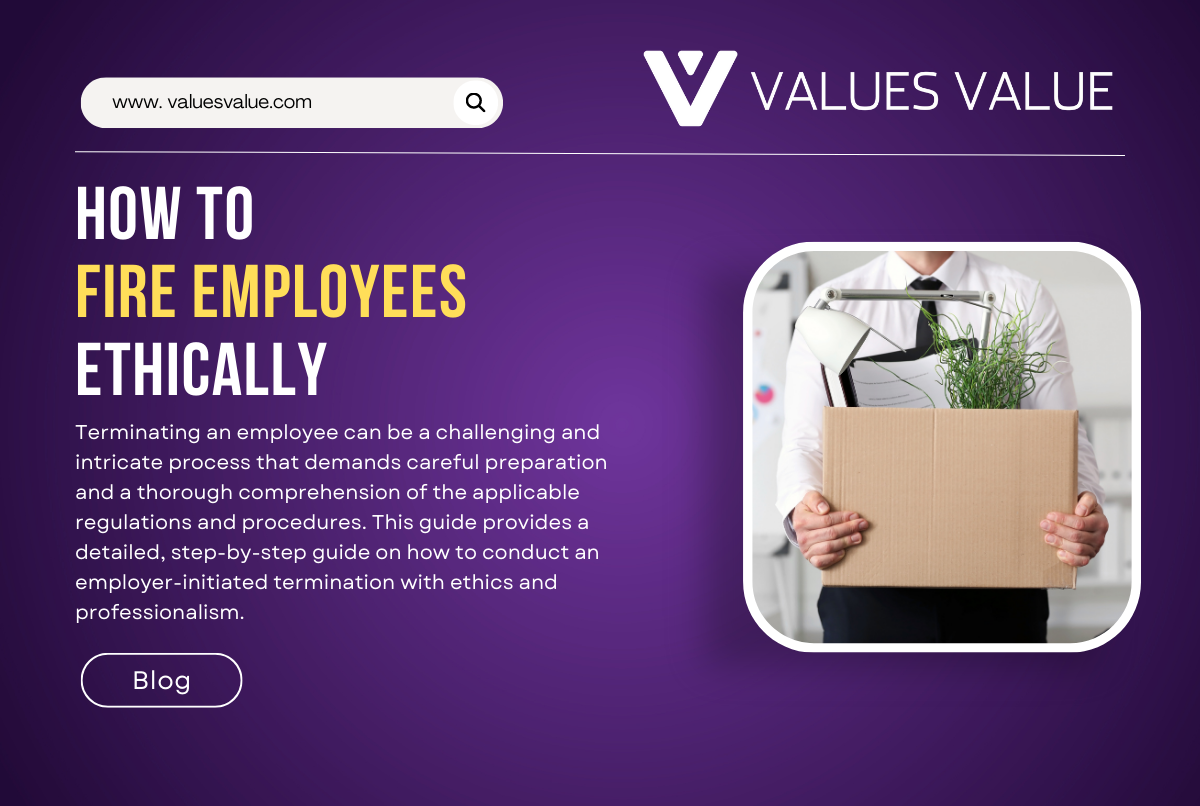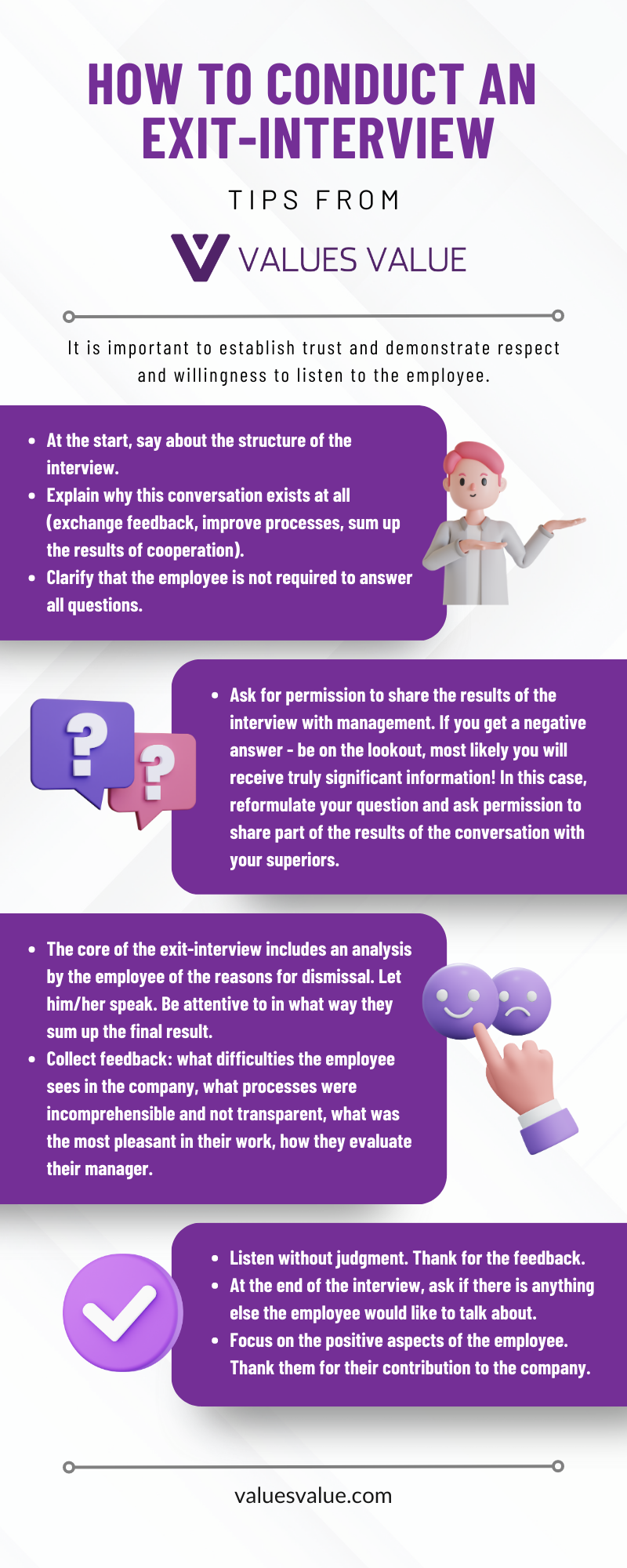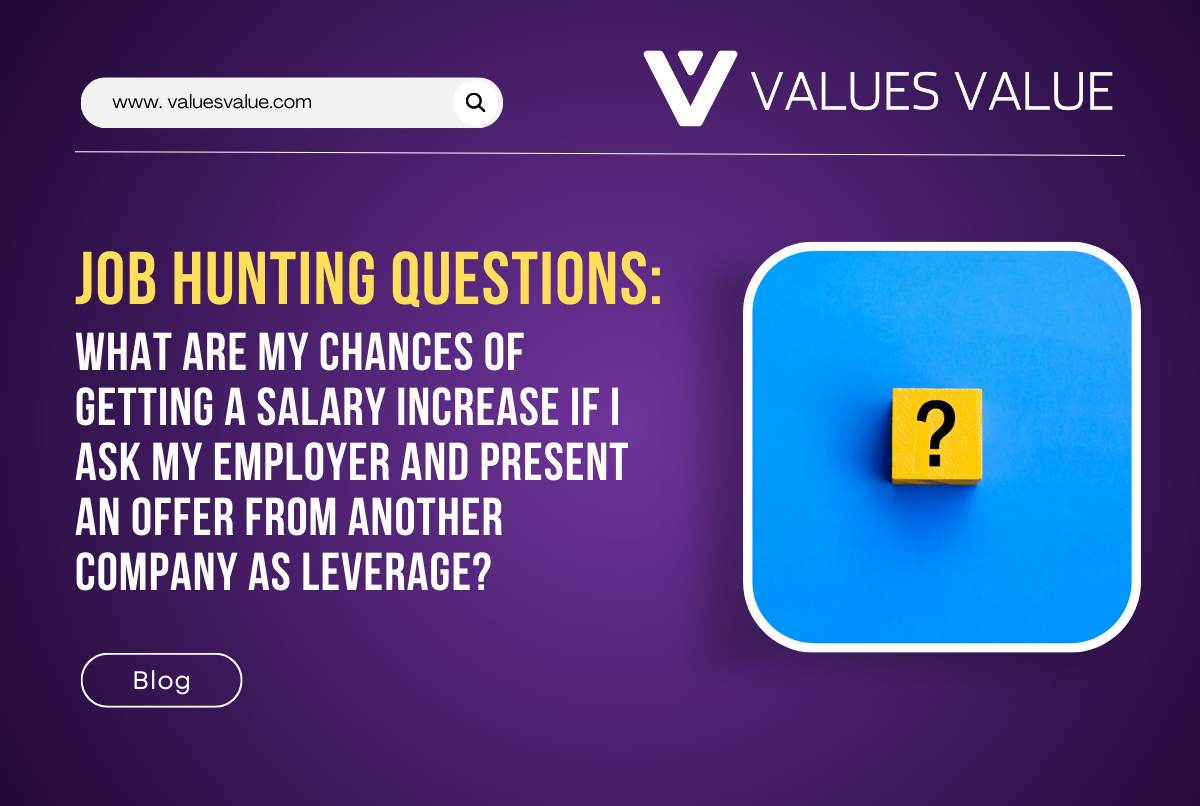 We will tell you how to ethically fire employees (almost) without harming the company’ and the HR’ brand.
We will tell you how to ethically fire employees (almost) without harming the company’ and the HR’ brand.
In this guide you will learn
- Basics about layoffs
- Step-by-step dismissal algorithm
- How to conduct an exit-interview
- Mass layoffs: how not to bury the HR brand
Intro
It’s hard to quit a job, as well as it’s hard to dismiss. But when hiring a person, you, as a manager, must already include this event in the future scenario. Either the employee decides to leave the company one day, or you decide to leave them – because of their inefficiency, because of staff optimization, because of something else.
In this guide, you will find step-by-step instructions on how to carry out layoffs at the initiative of the employer.
And immediately we emphasize: (preferably) the manager who hired them and who worked with them should dismiss the employee.
Dismissal algorithm
1. Start with a transition period plan
Perhaps before dismissing an unproductive employee, you should find a replacement for him inside or outside the team at first. Be sure to plan who and how will receive tasks. Assess the workload, the competence of the one who will temporarily replace the dismissed. It may be worth adjusting their salary during the transition period.
Before talking to the employee, determine the terms of the dismissal and what the company can offer them. All of this should be said during the first conversation about the termination of cooperation. You will make financial calculations later, you will also find about them in this list.
2. Conversation about termination of cooperation
Be polite and justify your decision. Don’t give hints, don’t use phrases like “well, you understand everything yourself”, be direct and honest, but remain ethical.
The employee should hear from you a clear message that you are firing him and doing this for the following reasons – they can be described in several sentences. The reasons must be clear (understandable) and truthful. Don’t make excuses and turn into a psychotherapist, but be prepared for emotions and tears – being fired is a very traumatic event. Yes, for you too. So think ahead about how you will recover from this unpleasant conversation.
By the way, yes! Exactly the conversation! If you do not have the opportunity to meet with an employee in person, let it be a video call. But try to make it private, let none of your colleagues become accidental witnesses.
Don’t set yourself a meeting in your calendar after this conversation in half an hour: the conversation may drag on, or you may need a pause to calm down a bit.
3. Determine the turnaround time
After planning the transition period and talking with the employee about the termination, decide together on their last day on the job. Prepare a list of tasks to be completed in the remaining time. Start handover processes.
4. Offer to help the employee you are firing
Focus on your capabilities, resources and be humane. It is in your power not to turn the dismissal into a conflict and “smooth the corners”.
What help can be offered?
- A HR manager can prepare an individual career development plan for an employee, politely pointing out their weaknesses, emphasizing strengths: perhaps the employee should improve hard or soft skills, undergo training, and establish personal time management.
- Offer to help to conduct a resume.
- Give the employee a recommendation.
- Bring the employee to the labor market. Write a post on social networks, inform potential employers about the released candidate and how they can be useful to another team. Or contact them with a recruiting agency.
5. Inform the team
Important! The team should not learn about the departure of a colleague on the last day. Do not delve into the details of the dismissal, but do not keep it under lock and key. Give the employee the opportunity to say goodbye to colleagues and leave with dignity.
6. Control the transfer of tasks and close access
- Check whether all tasks have been reassigned, whether there are any processes or communications left that are still on to the dismissed employee.
- Get access to documents in the employee’s work cloud, make copies of the files necessary for further work, or generally transfer documents to another employee who will replace the dismissed one.
- On the last working day, ask the employee to leave the chats.
- Close their access to all work services.
- Delete information about the dismissed person from the shared workspace.
7. Conduct an exit-interview
The last conversation with the employee is very important. It is appropriate to conduct it in the format of an exit-interview. A HR manager or supervisor may be present at the meeting from the employer. Better yet, conduct two interviews so that the employee can talk to both HR and the manager in private.
Such an interview helps to reduce the level of negative emotions in a person leaving the company, and this is important both for an HR-brand and just for being a human.
During the final conversation, many open up and share what really bothers them. It is here that you can learn about hidden conflicts in the team, about the intrigues of colleagues, about unfulfilled hopes, about who in the team is thinking of leaving.

8. Make financial calculations
By this time, you should already have an agreement with the employee on how you formally dismiss him: by agreement of the parties or on their initiative.
Be generous, offer a compensation package. It depends on the former position of the employee and on the time of their work in the company, but basically includes compensation, vacation compensation, bonuses. If this is a layoff, be sure to check with the law and pay as much salary as you have to.
Generosity can protect you not only from courts and complaints to labor inspectorates, but also from unrest in the team: employees who are upset by the dismissal of a colleague will certainly be reassured by the knowledge of decent compensation.
9. Terminate the contract
Document the resignation. Sign release agreements, if necessary. Update your non-disclosure agreement (NDA).
Important! When dismissing an employee working remotely, do not forget to send them the original order of dismissal by mail.
10. And the last. Always keep all agreements.
Mass layoffs
The decision to lay off staff is unlikely to be made and impulsively implemented overnight. If the company is facing mass layoffs, prepare for them and act according to the law. Explore whether your country needs to notify the employment service, unions and workers themselves in advance and other pitfalls.
Examine the staffing table and evaluate who cannot be laid off (pregnant women, single parents, guardians), and who can be offered a different position. Take staff optimization with the full seriousness of an effective manager, but don’t forget that layoffs will hit people, don’t play with their feelings and expectations.
As with targeted layoffs, stay within the work ethic. What does it mean?
- Do not announce your layoffs with a mass mailing!
It’s impolite and can hurt you. If one of the offended employees leaks (and someone will definitely leak) the text or screenshot of your letter to the network, there is a risk that the public will draw the wrong conclusions without having the full context.
- Do not announce mass layoffs on a general video call!
The conversation with the employee you decide to fire is very important, and it should be held in a 1-on-1 format. Respect the privacy of the employee, give them the opportunity to speak, listen to them.
- It is best to announce the dismissal to everyone personally and on the same day.
If you are firing several people, it is possible to arrange 1-on-1 meetings with everyone and practically at the same time. Act through the leads: let them conduct personal conversations.
If you need to fire one hundred employees and there are managers among them and there is no way to have personal dialogues, you can announce your decision during a meeting by bringing together employees of the same department, team or division on a call.
If you do notify the team in writing about layoffs, be polite, speak directly about the reasons for the dismissal, immediately write out the compensation package and thank them for their contribution to the company. Discuss the opportunity for the employee to communicate with the manager and HR in person. If such a letter scatters over the network, nothing will threaten you, since you proceed from the position of caring for the employee even at this painful stage.
- Talk to the team.
One of the most frustrating complications of mass layoffs is turbulence in the company among those you decide to keep and now want to hold.
We recommend an open dialogue with all employees, both those who leave and those who stay. Hold an online or offline meeting with all employees, during which you explain the reasons for the reductions, tell them about the company’s prospects, and answer all questions. We know examples where cutbacks have rallied teams.
After such a meeting, you can send out a letter from the first person of the company, where all employees will once again read the reasons for such a management decision, the company’s strategy for the near future and gratitude to those leaving. Leaking such a letter will most likely not harm your employer brand.

”Unfortunately, mass layoffs always have a negative impact on the HR’ brand, but in order to minimize the damage, it seems to me that the first thing to do is to be frank with employees: to explain why this happened. It is necessary to conduct an exit interview (get feedback from an employee, eliminate negativity, find out how we can help).
Since the layoff is massive, you can conduct general training that will help with the future job search (preparation of a resume, recommendations that will help to "sell" yourself during an interview). You can also share lists of laid off employees with trusted staffing agencies that can help with subsequent placements.
We hope this guide will help you navigate the difficult issue of layoffs.
Good luck to you and your employees!








